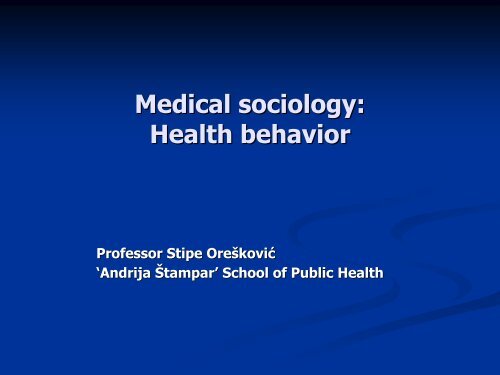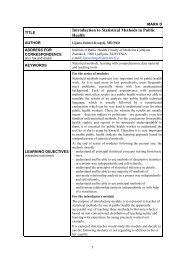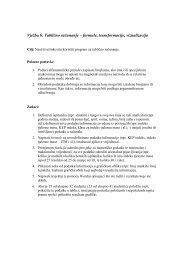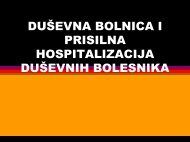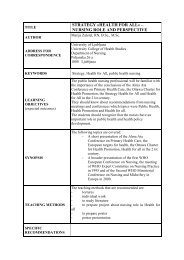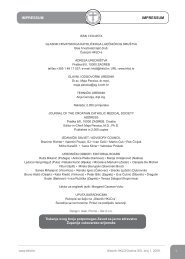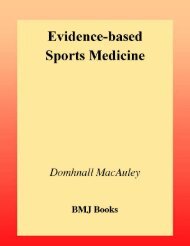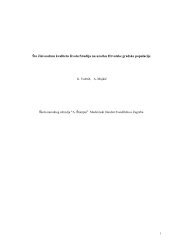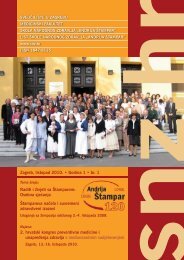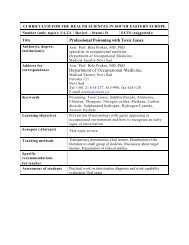Health behavior
Health behavior
Health behavior
- No tags were found...
You also want an ePaper? Increase the reach of your titles
YUMPU automatically turns print PDFs into web optimized ePapers that Google loves.
Medical sociology:<strong>Health</strong> <strong>behavior</strong>Professor Stipe Oreškoviković‘AndrijaŠtampar’ School of Public <strong>Health</strong>
Definitions of basic forms of health <strong>behavior</strong>• <strong>Health</strong> <strong>behavior</strong> - sociological, psychological andeconomic concept by which we express the formsof human <strong>behavior</strong> that are stimulated, motivatedand associated with attempts made by individualsor community to improve their health, preventillness, and diagnose and/or cure a disease orprevent death
• Forms of health <strong>behavior</strong>:• positive health <strong>behavior</strong> – healthy lifestyle• preventive health <strong>behavior</strong>• illness <strong>behavior</strong> or help-seeking <strong>behavior</strong>• the sick role• utilization of health care/services
General theory of <strong>behavior</strong>• Common characteristicsdetermining a concrete<strong>behavior</strong>:• there is a stimulus(<strong>behavior</strong> is conditioned)• there is a motive (<strong>behavior</strong>is motivated)• there is a goal (<strong>behavior</strong> isconditioned by goal)• every <strong>behavior</strong> has certainpersonal characteristicsdetermined by theindividual’s personality
• External factors affecting <strong>behavior</strong> – filtered throughpersonal insight, perception and motivation of anindividual: group pressures, available information,experience, roles...• Concept of selective perception – choosing favorable andignoring unfavorable information• Difference in interpreting information among individuals• Cognitive system of an individual – conditioned by awide spectre of variables• Differences in motivation among individuals
Factors of health <strong>behavior</strong> (Kast and Rosenzweig, 1979)
Theories of health <strong>behavior</strong>• <strong>Health</strong> Belief Model• Mechanic’s general theory of help-seeking• Suchman’s model of stages of illness experience• Concept of sickness career• Situational-adaptation model
1. <strong>Health</strong> Belief Model• an individual does not take any health action unlesshe/she has the minimum level of relevant healthmotivation and knowledge; unless he/she seeshimself/herself as potentially susceptible person, andunless he/she does not see the benefit of health care• components:• subjective state of ‘readiness to take action’• individual assessment of intentional health <strong>behavior</strong>• there should be a ‘trigger for action’ to stimulate acertain health <strong>behavior</strong>
• health action taken by an individual depends on his/herperception of his/her personal susceptibility and whetheran illness could have more severe personal implications• assumption of this model - that the outcome of theaction taken is reduced susceptibility to disease or, if adisease occurs, reduction of its severity• this model showed great importance in analysis ofpreventive and/or positive health <strong>behavior</strong>; alsoapplicable to analysis of illness <strong>behavior</strong>
<strong>Health</strong> Belief Model (Becker and Maiman, 1975:12, 1985)
<strong>Health</strong> Belief Model adapted to explanation of illness <strong>behavior</strong> (Beckeret al., 1979:263)
<strong>Health</strong> Belief Model adapted to explanation of illness <strong>behavior</strong> and sickrole (Becker et al., 1979:266)
2. Mechanic’s general theory of help-seeking• Mechanic defines illness <strong>behavior</strong> as ‘…any state thatcauses, or might cause, that an individual becomesconcerned for his or her symptoms and seeks help’• Interest:• To explain variations in illness <strong>behavior</strong>• Behaviors of symptomatic individual and his/her significant otherprior to seeking professional help
• Oriented towards two factors:• perception (definition) of health situation by a concreteindividual and his/her significant other• ability of the individual (or his/her significant other) to take thatsituation• Thesis: illness <strong>behavior</strong> is a culturally and sociallylearned response – formed through learning,socialization and past experience• This model is suitable for predicting decisions made byan individual about contacting (or non-contacting) aphysician but it does not explain the later stages ofhealth <strong>behavior</strong>
Decision making on help-seekingDeterminants of illness<strong>behavior</strong> *Perception of symptomsCategories of illness <strong>behavior</strong> determinantsVisibility and recognition of symptomsExtent to which symptoms are perceived as dangerousAvailable information, knowledge, and cultural assumptionsNature of symptomsExtent to which symptoms disrupt family, work, and othersocial activitiesFrequency and persistence of symptomsAmount of tolerance for the symptomsInterpretation of symptoms/signsBasic needs that lead to denialOther needs competing with illness responsesResidual categoryCompeting interpretations that can be given to symptomsonce they are recognizedPsychological and financial costs (expressed in money,time and effort loss; costs related to social distance, stigma,and humiliation)* Determinants of illness <strong>behavior</strong> occurring at two levels : (1) self-defined, and (2) other-definedSource: Mechanic (1978, 1987, 1992)
3. Suchman’s model of stages of illness experience• Enables monitoring of all stages of illness <strong>behavior</strong>• Reaction to illness consists of 5 stages:• symptom experience• assumption of the sick role• medical care contact• dependent-patient role• recovery and rehabilitation
• Stage 1: Symptom Experience - includes awareness ofphysical change; assessment of change related toseverity; form of emotional reaction associated withassessmentReaction:• denial• acceptance of symptoms and entering the secondstage• delay – individual cannot make the decision – waitsfor further development of symptoms
• Stage 2: Assumption of the Sick Role – decision onadaptation to the sick role; illness becomes a socialphenomenon - the ill person seeks validation for sick rolefrom other persons• other persons in lay referral system deny request for sick role• acceptance of illness and provisional sick role - leading to thethird stage - medical care contact
• Stage 3: Medical Care Contact - ill person leaves layremedies and enters the professional care system• physician denies confirmation of request for sick role - patientaccepts - patient refuses (‘shopping’ phenomenon)• confirmation of illness – confirmation of request for sick role -entering the next stage - dependent-patient role
• Stage 4: Dependent-Patient Role – ill person makesdecision on illness treatment and becomes a patient• patient resistance to treatment regimen – uncompliant patient –‘shopping’• dependent patient strives insufficiently for recovery• patient and physician working together on recovery – gradualresuming of normal roles• Stage 5: Recovery and Rehabilitation –• recovery – patient accepts normal activities• gradual recovery• recovery process - relinquishing sick role - chronicpatients/malingerers• positive treatment outcome – patient joins the healthy
Stages of illness experience – decision-making process (Suchman,1965; according to Wolinsky 1988:122)
4. Concept of sickness career• Illness – disability - includes changes in social identityand <strong>behavior</strong>-related expectations• Concept of career – status change – an individual movesfrom one social identity to the other• Total status sum = career• sick-leave, ageing, dying - specific careers• Patient career - provisional statuses (social identities)and goal of sickness career depend on disease type,patient type, and social and cultural circumstances inwhich the sickness career develops
• Main decisions associated with change of socialidentities in sickness career:1. basic line of health state – different meanings of ‘being healthy’2. decision that a change has occurred in relation to a normal,healthy state3. decision that a certain change is important (deviation fromhealth) - assessment on symptom severity/seriousnessdependent on:- extent to which symptoms pervade the normal activities; symptomclarity; tolerance threshold; understanding concrete symptoms;assumptions of cause, prognosis; interpersonal impact; other lifecrises
4. decision that help is needed5. decision on form (type) of helpneeded6. decision on visit to a certainagent of treatment7. decision on type and degree ofcooperation with the agent oftreatment
• 3 outcomes of sickness career:• Recovery• all symptoms that initiated the treatment disappear• there is no more probability of symptoms returning• interruption of sickness career – acceptance of health role• Impairment – Disability• at the end of sickness career, the ill person does not considerhimself/herself ill any more but not completely healthy either• persons with disability have the status of minority – couldbecome objects of discrimination and stereotyping• Death• outcome of sickness career but also inevitable for any humanbeing
5. Situational-adaptation model(illness <strong>behavior</strong> by Angelo Alonzo)• Thesis: each individual copes with ‘multiple problems inmultiple situations’• 4 types of illness <strong>behavior</strong>: everyday, acute, chronic, andin life-threatening situations‣ Everyday illness <strong>behavior</strong>‣ Concept of restraint‣ Notion of compromise role: 4 types of situations‣ Type 1: no symptoms and signs of disease‣ Type 2: potential symptoms and signs of disease, psychological orsocial distress (danger, pain) or injuries, presently or in the future
‣ Type 3: leisure time oriented towards symptoms and signs ofdisease‣ Type 4: diagnostic, disease-oriented‣ Acute illness <strong>behavior</strong>‣ an individual observes reduction in his/her own ability torestraint symptoms and signs of disease in a series of situations‣ an individual should increase the frequency and duration oftype-3 situations (‘action interruptions’), should stopparticipating in some situations, involvement in type-4 therapysituations‣ Chronic illness <strong>behavior</strong>‣ Adaptation - state of living ‘less-than-normal’ - with constantsymptoms and signs of disease
‣ Illness <strong>behavior</strong> in life-threatening situations• Crisis of dealing with the diseaseDimensionsTypes of illness <strong>behavior</strong>of illness<strong>behavior</strong> Everyday Acute Chronic LifethreateningsituationsPrimaryprocessRestraint Coping Adaptation HandlingcrisisRole relations Compromise Weak Impaired AnomicPatientphysicianrelationshipindirect guidance -cooperationmutualparticipationactivity -passivitySource: Alonzo, 1984:508.
Andersen’s model of help-seekingfor medical care• 3 components:• Predisposition – sociodemographic variables, attitudesand beliefs about health care• Enabling factors – family income, health insurancecoverage, availability of services, access to a regularsource of care• <strong>Health</strong> needs – health status, disability or diagnosis –factors for seeking medical care• This model successful in describing variance in healthservices utilization• Does not explain why some processes are occurring


